Abstract
Global Navigation Satellite Systems (GNSS) require mitigation of ionospheric propagation errors because the ionospheric range errors might be larger than tens of meters at the zenith direction. Taking advantage of the frequency-dispersive property of ionospheric refractivity, the ionospheric range errors can be mitigated in dual-frequency applications to a great extent by a linear combination of carrier phases or pseudoranges. However, single-frequency GNSS operations require additional ionospheric information to apply signal delay or range error corrections. To aid single-frequency operations, the global positioning system (GPS) broadcasts 8 coefficients as part of the navigation message to drive the ionospheric correction algorithm (ICA) also known as Klobuchar model. We presented here an ionospheric correction algorithm called Neustrelitz TEC model (NTCM) which can be used as complementary to the GPS ICA. Our investigation shows that the NTCM can be driven by Klobuchar model parameters to achieve a significantly better performance than obtained by the mother ICA algorithm. Our research, using post-processed reference total electron content (TEC) data from more than one solar cycle, shows that on average the RMS modeled TEC errors are up to 40% less for the proposed NTCM model compared to the Klobuchar model during high solar activity period, and about 10% less during low solar activity period. Such an approach does not require major technology changes for GPS users rather requires only introducing the NTCM approach a complement to the existing ICA algorithm while maintaining the simplicity of ionospheric range error mitigation with an improved model performance.






Similar content being viewed by others
References
Hernández-Pajares M, Juan JM, Sanz J, Orus R, Garcia-Rigo A, Feltens J, Komjathy A, Schaer SC, Krankowski A (2009) The IGS VTEC maps: a reliable source of ionospheric information since 1998. J Geodesy 83(3–4):263–275. doi:10.1007/s00190-008-0266-1
Hochegger G, Nava B, Radicella SM, Leitinger R (2000) a family of ionospheric models for different uses. Phys Chem Earth Part C 25(4):307–310. doi:10.1016/S1464-1917(00)00022-2
Hoque MM, Jakowski N (2015) An alternative ionospheric correction model for global navigation satellite systems J Geodesy 89(4):391–406. doi: 10.1007/s00190-014-0783-z. ISSN 0949-7714
Hoque MM, Jakowski N, Berdermann J (2015) An ionosphere broadcast model for next generation GNSS. In: Proceedings of the ION GNSS 2012, Institute of Navigation, Tampa, Florida, USA, September 14–18, pp 3755–3765
IS-GPS-200G (2012) Global positioning system directorate systems engineering and integration interface specification. ARINC Research Corporation, El Segundo
Jakowski N, Hoque MM, Mayer C (2011) A new global TEC model for estimating transionospheric radio wave propagation errors. J Geodesy 85(12):965–974. doi:10.1007/s00190-011-0455-1
Jones WB, Gallet RM (1962) The representation of diurnal and geographical variations of ionospheric data by numerical methods. ITU Telecommun J 29(5):129–149
Klobuchar JA (1987) Ionospheric time-delay algorithm for single frequency GPS users. IEEE Trans Aerosp Electron Syst AES 23(3):325–332. doi:10.1109/TAES.1987.310829
Nava B, Coisson P, Radicella SM (2008) A new version of the NeQuick ionosphere electron density model. J Atmos Terr Phys (JASTP) 70(15):1856–1862. doi:10.1016/j.jastp.2008.01.015
Noll CE (2010) The crustal dynamics data information system: a resource to support scientific analysis using space geodesy. Adv Space Res 45(12):1421–1440. ISSN 0273-1177
Schaer S, Beutler G, Rothacher M (1998) Mapping and predicting the ionosphere. In: Dow JM, Kouba J, Springer T (eds) Proceedings of the 1998 IGS analysis center workshop, ESA/ESOC, Darmstadt, pp 307–318
Wu XXHu, Wang G, Zhong H, Tang C (2013) Evaluation of COMPASS ionospheric model in GNSS positioning. Adv Space Res 51(6):959–968
Zhizhin M, Kihn E, Redmon R, Medvedev D, Mishin D (2008) Space Physics Interactive Data Resource—SPIDR. Earth Sci Inform 1(2):79–91. doi:10.1007/s12145-008-0012-5
Acknowledgements
We would like to give thanks to sponsors and operators of NASA’s Earth Science Data Systems and the CDDIS for archiving and distributing the IGS data. We would like to give thanks to NOAA’s NGDC for disseminating historical solar and magnetic data via SPIDR. Also thanks to NOAA’s NGS for making daily GPS ICA coefficients available.
Author information
Authors and Affiliations
Corresponding author
Rights and permissions
About this article
Cite this article
Hoque, M.M., Jakowski, N. & Berdermann, J. Ionospheric correction using NTCM driven by GPS Klobuchar coefficients for GNSS applications. GPS Solut 21, 1563–1572 (2017). https://doi.org/10.1007/s10291-017-0632-7
Received:
Accepted:
Published:
Issue Date:
DOI: https://doi.org/10.1007/s10291-017-0632-7




